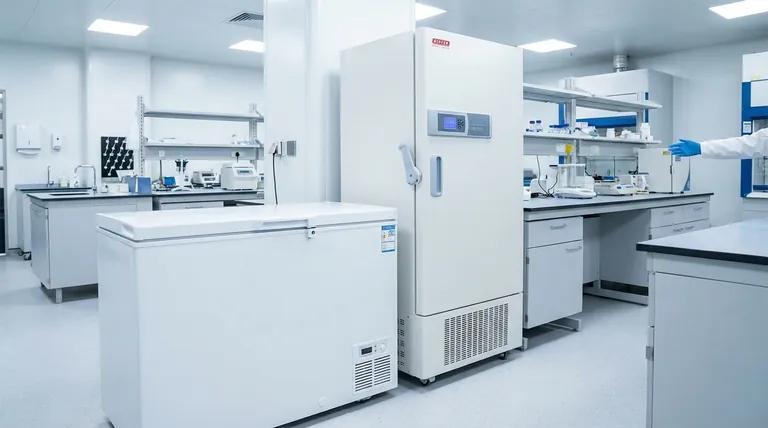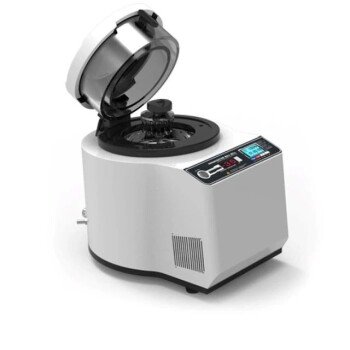At its core, an Ultra-Low Temperature (ULT) freezer comes in two main configurations: the upright, vertical model and the horizontal chest model. Your choice between them hinges on a fundamental trade-off between everyday convenience and long-term energy efficiency. Upright freezers offer superior accessibility and a smaller footprint, while chest freezers provide better temperature stability and lower operational costs.
The decision between an upright and a chest ULT freezer is not about which is "better," but which aligns with your laboratory's specific priorities. You are choosing between optimizing for workflow and space versus optimizing for sample integrity and energy conservation.

The Two Primary Configurations: Upright vs. Chest
The physical orientation of a ULT freezer is its most defining characteristic, directly influencing how it performs and fits into a laboratory environment.
Upright Freezers: Optimized for Access and Space
Upright freezers resemble a standard household refrigerator, with a front-opening door and adjustable internal shelves. This design is built for convenience.
Samples are easy to organize, see, and retrieve, making these models ideal for labs where materials are accessed frequently by multiple users. Their vertical design also occupies a minimal floor footprint, a critical advantage in crowded lab spaces.
Chest Freezers: Built for Stability and Efficiency
Chest freezers feature a top-opening lid. This simple design difference is the key to their superior thermal performance.
Because cold air is denser than warm air, it remains inside the freezer cavity when the lid is opened. This minimizes temperature fluctuations and reduces the energy required to re-cool the unit, making chest freezers the more energy-efficient and stable option for long-term, undisturbed storage.
Key Decision Factors Analyzed
Beyond the basic design, several practical factors must be weighed to determine the right fit for your application.
Footprint and Lab Space
An upright freezer's smaller footprint makes it the default choice for labs with limited floor area. They leverage vertical space more effectively.
A chest freezer requires a significantly larger, unobstructed floor area and can be more difficult to place within an existing lab layout.
Sample Accessibility and Workflow
For high-traffic environments, the upright model is unmatched. Its shelving system allows for intuitive organization and quick retrieval, minimizing door-open time per user.
Accessing samples in a chest freezer often requires bending over and searching through stacked racks. This can be cumbersome and is best suited for archiving samples that are rarely needed.
Temperature Stability and Sample Integrity
This is the most critical scientific consideration. The chest freezer's top-opening design inherently protects samples from ambient temperature swings during access.
Every time an upright freezer door is opened, a large volume of cold air spills out and is replaced by warmer, humid air. This forces the compressor to work harder and can expose sensitive samples to repeated, brief warming cycles.
Energy Consumption and Operational Cost
Due to their superior thermal efficiency, chest freezers consistently consume less energy than upright models of a similar volume. This translates to lower long-term operational costs.
Modern upright freezers have improved insulation and compressor technology, but they cannot overcome the fundamental physics of cold air loss from a front-opening door.
Understanding the Trade-offs
Choosing a freezer configuration involves accepting a set of compromises. Being aware of them is essential for making an informed decision.
The Hidden Cost of Convenience (Upright)
The ease of access offered by an upright freezer comes at the cost of higher energy bills and increased risk to sample integrity if door discipline is not maintained. Their convenience can encourage frequent and prolonged openings, exacerbating temperature fluctuations.
The Ergonomic Challenge (Chest)
The superior stability of a chest freezer comes with physical and organizational challenges. Poorly organized inventory can lead to prolonged lid-open times as users search for samples, partially negating the freezer's efficiency advantage and causing ergonomic strain.
Making the Right Choice for Your Lab
Your final decision should be guided by a clear understanding of your primary goal.
- If your primary focus is frequent sample access and optimizing limited lab space: Choose an upright freezer and enforce strict protocols for minimizing door-open times.
- If your primary focus is long-term archival storage and minimizing energy costs: Choose a chest freezer and invest in a well-organized inventory system.
- If your primary focus is storing a very small quantity of samples at a personal workstation: Consider a compact under-counter or tabletop model as a specialized alternative.
Ultimately, aligning the freezer's inherent strengths with your lab's daily workflow will ensure the best protection for your valuable samples.
Summary Table:
| Feature | Upright Freezer | Chest Freezer |
|---|---|---|
| Best For | Frequent access, space-limited labs | Long-term storage, energy savings |
| Accessibility | Easy, front-door access with shelves | More difficult, top-lid access |
| Temperature Stability | Lower (cold air escapes when door opens) | Higher (cold air stays in) |
| Energy Efficiency | Lower | Higher |
| Lab Footprint | Smaller (vertical design) | Larger (requires more floor space) |
Protect your valuable samples with the right Ultra-Low Temperature solution.
Choosing between an upright and chest ULT freezer is a critical decision for your laboratory's efficiency and sample integrity. KINTEK specializes in lab equipment and consumables, serving laboratory needs with expert guidance and reliable products.
Let our specialists help you select the perfect ULT freezer configuration for your specific workflow, ensuring optimal performance and long-term value.
Contact KINTEK today for a personalized consultation and discover how we can support your research with the right equipment.
Visual Guide

Related Products
- 708L Ultra Low Temperature Freezer High Performance Laboratory Freezer
- 608L Essential Laboratory Ultra Low Temperature Freezer For Critical Sample Preservation
- 58L Precision Laboratory Ultra Low Temperature Upright Freezer for Critical Sample Storage
- 28L Compact Upright Ultra Low Temperature Freezer for Laboratory
- 308L Precision Ultra Low Temperature Freezer for Laboratory Applications
People Also Ask
- Where are ultra low temperature freezers commonly used? Essential for Labs, Hospitals, and Biotech
- What is the price range for ultra low temperature freezers? Protect Your Samples with the Right Investment
- How do Ultra-Low Temperature freezers ensure the integrity of microbiological samples? Maintain Stability for Critical Research
- What temperature range do Ultra-Low Temperature freezers maintain? The -80°C Standard for Sample Integrity
- What factors should be considered when selecting an ultra-low temperature freezer? Ensure Sample Integrity and Long-Term Value



















